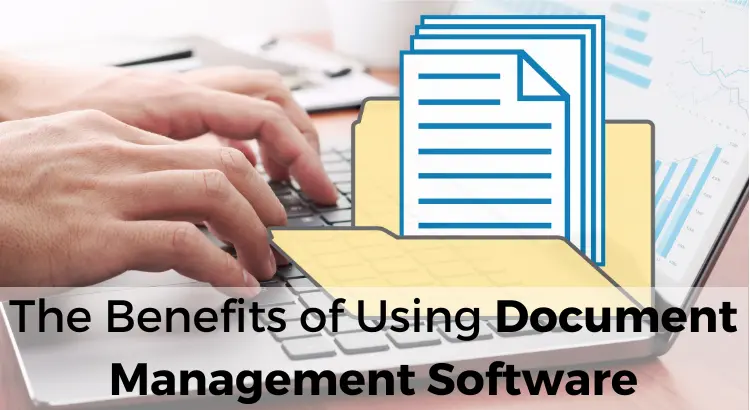Are you tired of spending endless hours organizing, searching for, and sharing documents? Document management software can help you streamline your document-related tasks, saving you time and improving your workflow. But with so many software solutions available, how do you know which one is right for your business?
In this article, we’ll explore the top 5 document management software solutions, their features, pricing, and how to choose the best software for your business.

The Benefits of Using Document Management Software
Document management software can help you reduce paper usage, improve collaboration, and increase productivity. With document management software, you can store, organize, and share files from a centralized platform, eliminating the need for multiple copies and versions of the same document. This can help you avoid confusion, errors, and wasted time.

Moreover, document management software can help you track changes, access documents from anywhere, and automate workflows. Some software solutions even offer advanced features such as version control, document security, and analytics. These features can help you stay compliant, reduce risk, and gain insights into your document-related processes.
Related Post: 5 Most Latest Trends in Document Management Software
Key Features to Look for in Document Management Software
When choosing document management software, it’s essential to look for key features that can help you streamline your document-related tasks. Some of the features to consider include:
- Document storage and organization: The software should allow you to store and organize documents in a centralized location, making it easy to find, access, and share files. The software should also have a user-friendly interface, allowing you to navigate through folders and documents easily.
- Collaboration and sharing: The software should allow you to collaborate and share documents with team members and external stakeholders. This can include features such as commenting, editing, and version control.
- Automation and workflows: The software should allow you to automate tasks and workflows, such as document approvals, notifications, and reminders. This can help you save time and reduce errors.
- Document security: The software should have robust security features, such as access controls, encryption, and audit trails. This can help you protect sensitive information and stay compliant with regulations.
- Integration and customization: The software should integrate with other tools and systems you use, such as CRM, ERP, and email. This can help you streamline your workflow and avoid duplication of efforts. The software should also be customizable, allowing you to adapt it to your specific needs.
Top 5 Document Management Software Solutions
Now that you know what to look for in document management software, let’s explore the top 5 software solutions you should consider.

Microsoft SharePoint
Microsoft SharePoint is a cloud-based platform that allows you to store, organize, and share documents from a central location. SharePoint offers features such as version control, access controls, and workflow automation.
While SharePoint offers a comprehensive solution for document management, it is essential to consider the associated costs before making a decision. For a detailed analysis of the pricing structure and the factors that can impact the total cost of ownership, check out this post about SharePoint cost.
Keep in mind that the cost may vary depending on the size of your organization, the level of customization required, and the specific features needed. By understanding these expenses, you can make a more informed decision on whether SharePoint is the right document management software solution for your organization.
SharePoint also integrates with other Microsoft tools, such as Office 365 and OneDrive, making it easy to collaborate and share documents.
Pricing: SharePoint is included with Office 365 subscriptions, starting at $5/user/month.
Google Drive
Google Drive is a cloud-based platform that allows you to store, organize, and share documents, spreadsheets, and presentations. Google Drive offers features such as real-time collaboration, version control, and access controls.
Google Drive also integrates with other Google tools, such as Gmail and Google Calendar, making it easy to collaborate and share documents.
Pricing: Google Drive offers various pricing plans, starting at $6/user/month for Google Workspace Basic.
Dropbox Business
Dropbox Business is a cloud-based platform that allows you to store, organize, and share files securely. Dropbox Business offers features such as automatic backup, file recovery, and version control. Dropbox Business also integrates with other tools, such as Microsoft Office and Slack, making it easy to collaborate and share documents.
Pricing: Dropbox Business offers various pricing plans, starting at $15/user/month.
Box
The box is a cloud-based platform that allows you to store, organize, and share files securely. Box offers features such as access controls, version control, and workflow automation. Box also integrates with other tools, such as Salesforce and Microsoft Office, making it easy to collaborate and share documents.
Pricing: Box offers various pricing plans, starting at $5/user/month for the starter plan.
DocuWare
DocuWare is an on-premise or cloud-based platform that offers document management, workflow automation, and electronic signature capabilities. DocuWare offers features such as access controls, version control, and mobile access.
DocuWare also integrates with other tools, such as SAP and Salesforce, making it easy to collaborate and share documents.
Pricing: DocuWare offers various pricing plans, starting at $375/month for the cloud-based version.
How to Choose the Best Document Management Software for Your Business?

When choosing document management software, it’s essential to consider your specific needs and requirements. Consider the size and complexity of your business and the volume of documents you manage.
If you have a large business with multiple departments and locations, you may need a more robust software solution. Note your industry-specific regulations and compliance requirements. Some industries, such as healthcare and finance, have strict regulations regarding document management and security.
Look at the tools and systems you currently use and whether the software integrates with them. Integration can help you streamline your workflow and avoid duplication of efforts. Factor the pricing plans and whether they fit within your budget. Also, consider the scalability of the software solution and whether it can grow with your business.
Implementation and Training
Implementing and training your team on document management software is essential to ensure successful adoption and use. Set clear goals and expectations for the software’s use and communicate them to your team.
This can help ensure everyone is on the same page and working towards the same objectives. Provide adequate training and support to your team to ensure they know how to use the software effectively. This can include online tutorials, user guides, and training sessions.
Monitor and evaluate the usage of the software to ensure it’s meeting your business needs and objectives. This can help you identify any challenges or areas for improvement.
Common Challenges and How to Overcome Them
Implementing document management software can come with challenges such as resistance to change and technical difficulties. Communicate the benefits of using DMS to your team to help overcome resistance to change. This can include improved productivity, collaboration, and compliance. Provide adequate support to your team to help overcome technical difficulties.
This can include IT support, user guides, and training sessions. Continuously evaluate and improve your document management workflow to ensure it’s meeting your business needs and objectives. This can help you identify any areas for improvement and make necessary adjustments.